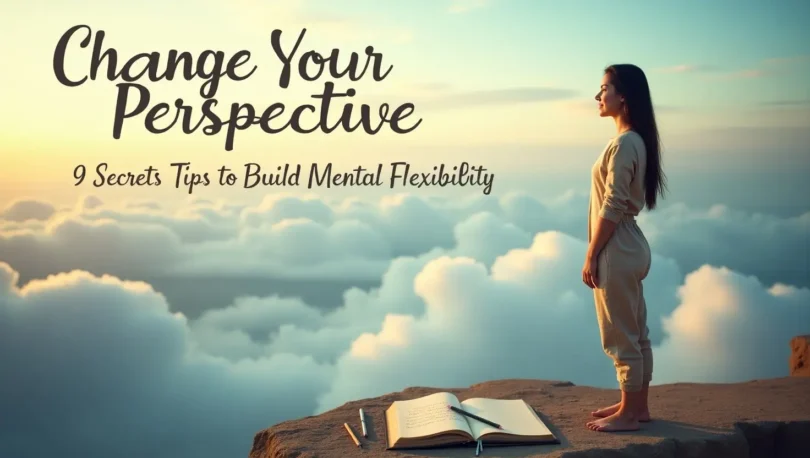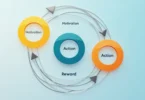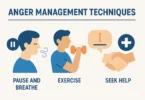Ever catch yourself stuck in the same thought loop, reacting the same way to problems, and feeling like growth is just out of reach? That’s not a lack of potential — it’s a signal that it’s time to change your perspective.
Perspective shapes everything. How you view a setback, a challenge, a new opportunity — it all filters through your current mindset. But here’s the good news: that mindset isn’t fixed. With a little practice and the right tools, you can train your brain to adapt, stretch, and shift. That’s where mental flexibility comes in.
Mental flexibility is the ability to see situations from different angles, respond instead of react, and embrace change with curiosity rather than fear. It’s a core skill of the growth mindset, and in this post, we’ll break down 9 powerful tips to help you build it.
Why Change Your Perspective for a Growth Mindset
Understanding the Change Your Perspective
When it comes to shifting your life in a more positive and progressive direction, the first step is to change your perspective — and that starts with understanding how your mindset shapes the way you think, feel, and respond.
Carol Dweck, a leading psychologist, introduced the powerful concept of the growth mindset. She describes it as the belief that abilities and intelligence can be developed through effort, learning, and perseverance. In contrast, a fixed mindset believes our qualities are static and unchangeable — which can lead to fear of failure, resistance to change, and avoidance of challenges.
So why does this matter for perspective?
Because a growth mindset naturally supports mental flexibility. When you believe that you can grow, you’re more open to reframing experiences. You’re more likely to say, “What can I learn from this?” instead of “Why is this happening to me?” That shift alone is the difference between stagnation and progress.
Changing your perspective isn’t about denying your current reality — it’s about choosing to look at it differently, which is exactly what a growth mindset trains your brain to do.
The Role of Mental Flexibility in Personal Development
Mental flexibility is your brain’s ability to shift thinking, adjust to new situations, and respond creatively to challenges. It’s not just a nice-to-have skill — it’s essential for personal growth in a constantly changing world.
This is where adaptive thinking comes into play. When you’re mentally flexible, you can pivot without panicking. You can handle setbacks with grace. You’re not locked into one way of thinking — you explore alternatives, entertain new ideas, and challenge your own assumptions.
This Change Your Perspective is also closely tied to emotional intelligence — the ability to understand and manage your emotions. When you’re emotionally intelligent, you’re less reactive and more reflective. This allows for healthier perspective shifts, especially in emotionally charged situations.
Backed by neuroscience, this kind of transformation is totally possible. Thanks to neuroplasticity, your brain can rewire itself — creating new neural pathways when you adopt new ways of thinking. So yes, you can literally train your brain to become more flexible.
In short, changing your perspective isn’t just about attitude. It’s about developing the mental tools to handle life with more adaptability, confidence, and resilience.
9 Tips to Change Your Perspective and Build Mental Flexibility
Mental flexibility is like a muscle — the more you train it, the easier it becomes to shift your mindset and view challenges from a healthier, more constructive angle. Below are nine powerful tips that can help you change your perspective and cultivate a flexible mind that thrives on growth and resilience.
1. Practice Cognitive Reframing
Cognitive reframing is a technique rooted in Cognitive Behavioral Therapy (CBT) that helps you see a situation from a different point of view. Instead of labeling events as “bad” or “unfair,” ask yourself, “What else could this mean?” or “Is there another way to see this?”
For example, if you didn’t get the job you wanted, your initial thought might be “I’m not good enough.” But reframing can shift that to “Maybe this wasn’t the right fit, and something better is ahead.” This simple habit slowly trains your brain to respond, not react, and unlocks a deeper level of mental clarity.
2. Use Mindfulness to Observe Thought Patterns
Mindfulness is all about staying present and non-judgmentally aware of your thoughts and emotions. It gives you the space to notice your inner dialogue — and pause before spiraling into old thinking habits.
Try this: when you catch yourself in a negative loop, take a breath and just observe. Don’t fix it. Don’t analyze it. Just be aware of what you’re thinking and feeling. That awareness creates the mental room needed for new perspectives to emerge.
Mindfulness also helps boost self-awareness, which is key for challenging old beliefs and making intentional mindset shifts.
3. Ask Different Questions
Sometimes, changing your perspective is as simple as changing the questions you ask. Instead of asking “Why is this happening to me?”, ask “What can I learn from this?” or “How can this make me stronger?”
Great questions invite your brain to search for answers — and when you ask better questions, you open the door to better perspectives.
4. Surround Yourself with Diverse Perspectives
We tend to live in echo chambers — social circles or media bubbles that reinforce our existing beliefs. To break free, actively seek out people who challenge your thinking. Read books from different cultures. Listen to podcasts that present opposing viewpoints.
When you expose yourself to new ideas and unfamiliar opinions, your brain becomes more comfortable with complexity and ambiguity — both crucial ingredients for mental flexibility.
5. Embrace Failure as Feedback
People with a growth mindset don’t see failure as the end — they see it as data. They understand that missteps are part of learning, and every setback is a stepping stone.
So when you fail (because we all do), instead of saying “I blew it,” say “What can I take away from this?” Shifting your relationship with failure makes it easier to bounce back, reflect, and move forward with more wisdom.
6. Step Outside Your Routine
Routine can bring comfort, but it can also make our thinking rigid. Try mixing things up — take a different route to work, try a new activity, or work from a different environment.
These small changes challenge your brain to adapt and engage with new stimuli. Over time, they create mental agility that translates into more flexible thinking when bigger changes come along.
7. Challenge Your Automatic Thoughts
We all have subconscious beliefs — often shaped by past experiences — that guide how we interpret the world. Start tuning into these automatic thoughts and questioning them.
Ask yourself:
“Is this thought helping or hurting me?”
“What’s the evidence that this thought is true?”
This habit builds mental discipline, making it easier to change your perspective and replace self-limiting beliefs with healthier, more empowering ones.
Recommended: Develop Rock-Solid Discipline with These 5 Must-Read Books
8. Keep a Perspective Journal
Writing is a powerful tool for reflection and reframing. At the end of the day, jot down one situation you struggled with and explore how you could view it differently.
Over time, this simple practice helps you identify patterns, reframe recurring thoughts, and build a more intentional relationship with your mind.
9. Celebrate Progress, Not Perfection
Shifting your mindset doesn’t happen overnight — and it doesn’t need to be perfect. Celebrate the small wins. Recognize when you caught yourself before reacting, or when you saw a challenge differently than you would’ve last year.
Progress builds momentum. And when you focus on growth over perfection, you naturally become more flexible, compassionate, and open-minded.
Build Long-Term Habits That Support a Change Your Perspective
Surround Yourself with Diverse Perspectives
One of the most powerful ways to change your perspective is to intentionally step outside your comfort zone and expose yourself to how other people see the world. When you regularly engage with diverse perspectives, you begin to break free from the mental echo chambers that often keep your thinking limited or rigid.
Most of us tend to gravitate toward people who think, speak, and act like we do — it feels safe, familiar, and validating. But while similarity is comforting, it doesn’t challenge your assumptions. And without challenge, there’s no growth.
Engaging with people from different backgrounds, cultures, belief systems, and experiences helps you realize that there are many valid ways to interpret the same situation. You might hear a viewpoint that contradicts your own — and that’s not a threat, it’s an opportunity. It pushes you to reflect, question your internal narratives, and sometimes even discover blind spots in your own thinking.
Here are a few simple ways to start broadening your perspective:
- Read books or blogs written by people whose life stories differ from yours. Memoirs, cultural essays, and global fiction are great gateways into new ways of seeing the world.
- Follow diverse voices on social media — thought leaders, educators, or creatives from different walks of life. Their daily content can subtly shift your thinking over time.
- Strike up real conversations with people you wouldn’t normally engage with. Ask open-ended questions. Listen more than you speak. Stay curious, not judgmental.
- Join new communities or attend events that expose you to unfamiliar ideas. A workshop, a discussion group, or even a volunteer opportunity can change how you view life and others.
The goal isn’t to agree with everything you hear — it’s to understand where others are coming from and stretch your cognitive and emotional boundaries. This Change Your Perspective helps reduce bias, deepen empathy, and sharpen your ability to navigate complex social or personal situations.
In short, when you surround yourself with diverse perspectives, you’re not just collecting opinions — you’re building the muscle of open-mindedness that makes perspective shifts second nature.
Embrace Discomfort and Uncertainty
If you’re serious about developing a flexible, growth-oriented mindset, here’s something you need to accept: discomfort is part of the deal.
Growth never happens in the comfort zone. It happens in those uneasy, in-between spaces — where you’re not quite sure what comes next, where you’re challenged emotionally or intellectually, and where your usual coping mechanisms don’t quite work. That’s not a flaw in the process; that is the process.
Learning to embrace discomfort and uncertainty is essential to changing your perspective. Why? Because rigid thinking thrives on predictability. It wants clear answers, safe outcomes, and zero ambiguity. But real life? Real life is messy, unpredictable, and often uncomfortable. The more you try to avoid that, the more stuck you become.
When you choose to lean into that uncertainty — to face the unknown rather than flee from it — you build emotional resilience. You teach your brain that uncertainty doesn’t mean danger. It just means growth is happening.
Here are a few ways to start:
- Sit with discomfort instead of escaping it. Whether it’s an awkward conversation, a tough decision, or an unfamiliar situation, try not to numb it or run from it. Pause. Breathe. Get curious about the feeling instead of judging it.
- Reframe uncertainty as possibility. Instead of thinking “I don’t know what’s going to happen — that’s scary,” try “I don’t know what’s going to happen — and that means anything is possible.” Uncertainty opens doors to new outcomes, not just unwanted ones.
- Take small risks daily. Try something new that feels slightly uncomfortable — speaking up in a meeting, saying no to something that drains you, or sharing a vulnerable thought. These micro-stretches build mental toughness over time.
It’s not about being fearless — it’s about being willing to move forward with fear and discomfort in your backpack. Because once you stop avoiding the unknown, you start reshaping your relationship with change. That’s when mental flexibility truly begins to flourish.
And the best part? Every time you embrace uncertainty and survive it (which you will), your confidence grows. You stop shrinking your world to fit your fears and start expanding your mindset to meet your potential.
Changing your perspective isn’t about pretending everything is perfect or forcing yourself to be positive. It’s about expanding the way you see — so you can navigate life with more clarity, less stress, and way more confidence.
From reframing negative thoughts to embracing discomfort and listening to voices different from your own, every tip you’ve just read is a stepping stone toward a more flexible and resilient mindset. And like any new habit, the more you practice, the more natural it becomes.
So the next time you feel stuck, overwhelmed, or uncertain, pause. Breathe. And ask yourself — what if there’s another way to see this?
Because once you start changing your perspective, you start changing your life — from the inside out.








Leave a Comment